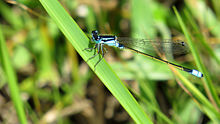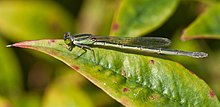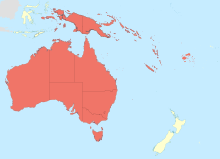
Back Ischnura heterosticta CEB Ischnura heterosticta Welsh Ischnura heterosticta French പൂത്താലിത്തുമ്പി Malayalam Ischnura heterosticta Dutch Ischnura heterosticta Polish اشنورا ہیٹیروسٹکٹا PNB Ischnura heterosticta Russian Ischnura heterosticta Swedish Ischnura heterosticta Vietnamese
| Ischnura heterosticta | |
|---|---|

| |
| Male Ischnura heterosticta | |

| |
| Female Ischnura heterosticta | |
| Scientific classification | |
| Domain: | Eukaryota |
| Kingdom: | Animalia |
| Phylum: | Arthropoda |
| Class: | Insecta |
| Order: | Odonata |
| Suborder: | Zygoptera |
| Family: | Coenagrionidae |
| Genus: | Ischnura |
| Species: | I. heterosticta
|
| Binomial name | |
| Ischnura heterosticta (Burmeister, 1842)[2]
| |

| |
Ischnura heterosticta, one of at least two species with the common name common bluetail,[3] is an Australian damselfly of the family Coenagrionidae.[4] It is the largest of the three Ischnura species in Australia.[5] They are generally found near slow-running or still water.[6] The species is also salt tolerant.[7] It flies from October to March.[5]
- ^ Dow, R.A. (2017). "Ischnura heterosticta". IUCN Red List of Threatened Species. 2017: e.T83124880A83377010. doi:10.2305/IUCN.UK.2017-1.RLTS.T83124880A83377010.en. Retrieved 20 November 2021.
- ^ Burmeister, Hermann (1839). Handbuch der Entomologie (in Latin). Vol. 2. Berlin: T.C.F. Enslin. pp. 805–862 [820] – via Biodiversity Heritage Library.
- ^ Cite error: The named reference
field guidewas invoked but never defined (see the help page). - ^ "Species Ischnura heterosticta (Burmeister, 1842)". Australian Faunal Directory. Australian Biological Resources Study. 2012. Retrieved 8 April 2017.
- ^ a b Cite error: The named reference
Tillyardwas invoked but never defined (see the help page). - ^ "Common Bluetail Damselfly - Ischnura heterosticta". brisbaneinsects.com. Retrieved 26 August 2015.
- ^ Kefford, Ben J. (2005-08-22). "Growth of the damselfly Ischnura heterosticta is better in saline water than freshwater" (PDF). Archived from the original (PDF) on August 30, 2007. Retrieved 2008-12-28.
© MMXXIII Rich X Search. We shall prevail. All rights reserved. Rich X Search
